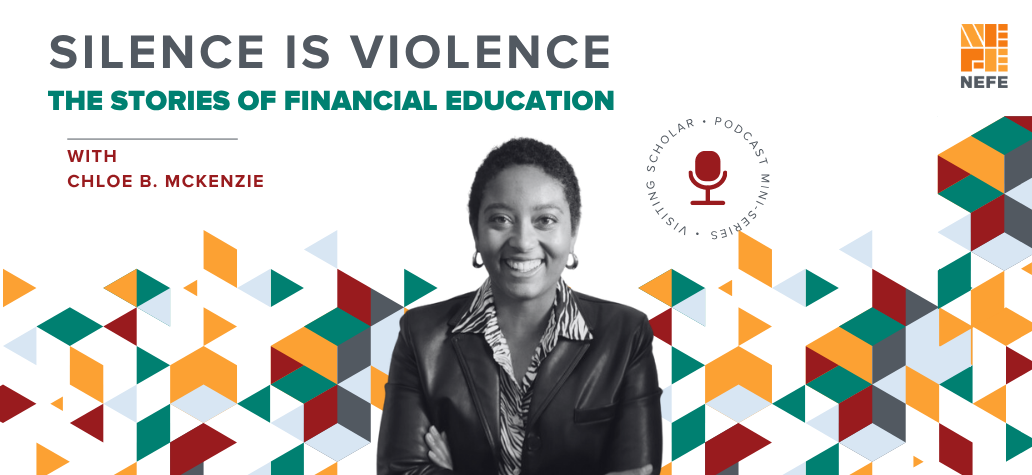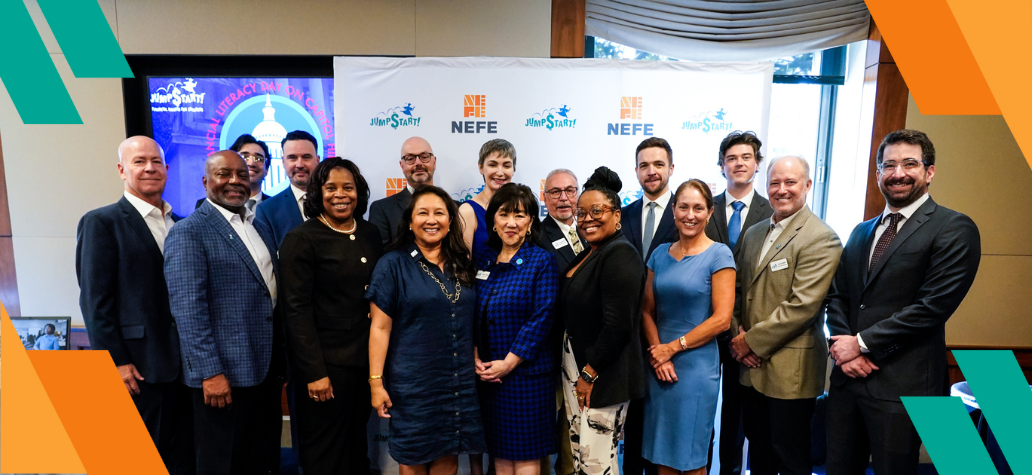The last 18 months as a resident at NEFE has reminded me of two quotes I come back to often in my research. One of my favorite authors, Sue Monk Kidd, said: “It is always difficult and risky to try to put soulmaking into words.” She went on to describe how liberating it is to “live your questions” instead of feeling the weight of always having to have the answers. Returning to Kidd’s statements as I continue to develop my theory on financial trauma has been necessary.
Equally, Audre Lorde famously wrote on a chalkboard, “Women are powerful and dangerous.” I first saw this picture before I had even named my theory, but I knew that's what I wanted:
“the impact to be, for my work and the influence it could have on our economic system to be powerful and dangerous.”
Taking these guiding philosophies together, as I close out my residency at NEFE, I felt it was necessary to fill in some of the gaps that I had to leave out in the pieces we published. Creating a cohesive body of work is hard, and it required that I leave certain things out; it required that I prioritize which questions to answer. So, for this final piece, I wanted to answer questions posed to me and questions I came up with alongside my colleagues at NEFE. I may leave you with more questions than answers (which I hope will not be disappointing), however, I can at least say I have some answers with varying degrees of completeness.
Recap of the work we published:
- Trauma after Trauma – Navigating Financial Anxiety in the Postpartum Period
- Understanding Racial Trauma's Impact on Financial Literacy
- Part One: The Myth of the Financial Personality Defect
- Part Two: Limited and Nonparticipation by Design
- Part Three: Limited and Nonparticipation as a Trauma Response
The Need for More Qualitative Research
Question: Why does my research intentionally lean more qualitative than quantitative?
Answer: Throughout my residency, I have consistently presented my qualitative studies. This was a very intentional choice—it’s a way to model the way I ensure that my research is powerful and dangerous. I did not spend much time calling out why I was doing this, so this seems like as good a time as any.
Often, researchers ask me why I do not measure financial trauma in monetary terms. I typically respond that I could, but that would mean I would not really be measuring the full extent of what financial trauma does to us in the way that I want to. I expand on why by posing the following questions: When thinking about the limitations of quantitative research, I always think about it in the context of, “What does (racialized, gender-based, etc.) oppression do to us?” How could a set of quantities adequately capture the texture of that overarching question? I’m asking these questions in earnest. I think quantitative measures can begin the conversation, not end it. Or, alternatively, quantitative measures can expand conversations, but only after the qualitative data has grounded us.
My goal has never been to present a theory constructed to easily adhere to the traditional form of empirical testing. Rather, my goal has been to construct a theory that explains how the post-trauma functioning of Black women—and other groups targeted by racism, sexism, and other forms of oppression—influences their wealth-building capability. As such, my theory on financial trauma intentionally ventures into areas where there likely is no data or that would not be best suited for empirical study by conventional methods.
But frankly, there is a simpler answer to this question.
I have found that quantitative methods rarely capture the full experiences of the most purposely ignored.
Of course, it’s helpful to know how much racism or sexism has cost Black women in terms of net worth, but how effectively does that speak to the extensiveness of the horrors and violence that Black women are required to experience as an imperative to secure material safety and build material wealth? While my decision to begin my theory of financial trauma is based on empirical findings, particularly work like Starkey et. al.’s work on the relationship between financial stress and depression, my theory is more focused on what Black women have been offering in their narratives and storytelling for decades.
This is important because it brings to the fore the unique and adverse experiences of Black women as the location of economic understanding. This is what qualitative research does: it more effectively honors the lived experiences of purposely ignored groups and requires researchers to derive their insights from data that has more social, historical and cultural context.
So, rather than medicalizing the concept of financial trauma or diluting its impact on wealth-building capability by over-relying on statistics to capture the multi-layered texture of the concept, I intentionally offer a theory that is meant to better understand the financial and socioeconomic choices of Black women as being driven by surviving and adapting to the harm they are structurally positioned to experience.
To clarify, though, this does not mean my efforts to measure financial trauma exclude quantitative measures. That is inaccurate. Rather, I prioritize the themes that emerge from my qualitative data to direct me on which quantitative measures would bring more richness to my understanding of the questions I have.
As I alluded to earlier, when I consider this question, I often think about the broader limitations (arguably, I feel like they are oppressive limitations) thrust upon researchers by the architects of academia and traditional research methods. This leads me to my next question.
The Problem of Generalizability: How White Supremacy Shows Up in Research Methodologies
Question: What conceptual definitions need refining? Redefining? Perhaps even eliminating?
Answer: I offer my theory on financial trauma as a tool accountable to the frameworks of transformative justice detailed by Staci K. Haines’ work in The Politics of Trauma, among others—a liberatory approach to violence and harm—and the conceptualization of intersectionality. So, when I say that my theory was not constructed to easily adhere to the traditional form of empirical testing, I mean it. To put it bluntly, I have often been uncomfortable with concepts like “generalizability” and “empiricism” because these concepts or requirements placed a burden on me—a Black woman researcher studying Black women—that rarely exists for researchers who enjoy racialized and gender privilege who study the “broader” population (which are predominately white).
My theory is powerful because it addresses what I call the trauma data gap, and it is dangerous because it is meant to be a heuristic device to help us expand our understanding of the relationship between wealth and trauma by prioritizing the most purposely ignored, who sustain this unrecognized form of trauma because conventional definitions of trauma are still influenced by sexist, white supremacist thinking.
I have no doubt that experiences of financial trauma are widespread across the gender and racial spectrum, but if I did not prioritize the most purposely ignored groups to develop the theory—really, if I chose to initially collect data that adheres to the principle of representative sampling—I don’t think my findings would be as revelatory as they have been.
The concepts of generalizability and representative sampling feel like being told that Black women’s’ experiences are adjunct to somebody else’s—namely those who enjoy racialized and gender privilege—because they have been more heavily prioritized in research or because they, for now, make up a larger share of the American population. Therefore, our experiences and unique struggles against wealth inequality are not inherently valuable and can only become valuable when we explain them in terms that make sense to those in power.
My theory on financial trauma doesn’t just explain what it is and what it does to us; it also requires us to understand socioeconomic experiences from a sociopolitical and historical perspective, something that prevailing narratives and research seldom capture. It compels us to prioritize Black women and their experiences more intentionally and in their own way. This is why I have rebuked feedback that I’m oversampling Black women and other purposely ignored groups and that I should be prepared to explain why I do not participate in representative sampling. To that, I say, “That’s not my standard.” Those who enjoy racialized, gender and economic privilege can take the insights and do the generalizing themselves and learn why oversampling purposely ignored groups is an act of correcting centuries of erasure in research; that should not be the task of those systematically denied their privilege (and that includes the researcher).
I offer researchers the liberatory feeling of broadening our definition of generalizability, representative sampling and empiricism. If generalizability currently requires us to provide findings that can be applied to most contexts, most people, most of the time, are we being powerful and dangerous? Are we perpetuating oppression? Honestly, ask yourself why that is necessary in order for our insights to be considered valid. If representative sampling requires us to represent the characteristics of the broader population, aren’t we practicing erasure in some sense (even if that’s not our intent)? Empirical research currently requires us to strictly draw our conclusions on “concrete” and “verifiable” evidence, and it’s hard not to look at this definition and consider how often Black women are told that our experiences and our pain are not real, and therefore not something measurable or that could be measured.
Ultimately, I answer this question with an invitation to answer another question: How often and to what extent are you considering how white supremacy shows up in our research methodologies? What would it look like to directly address this? When you have those answers, I offer that you intentionally design your research methods around that. That’s what I’m doing: constantly questioning.
Future Work in Financial Trauma
Question: What questions have I asked myself throughout the residency but have yet to fully work through?
Answer: I keep a physical journal and a virtual journal (for those moments I can’t go grab my physical one). I recently wrote down that my efforts to measure financial trauma are opportunities to measure violence and harm, but not (only) in monetary terms. As mentioned previously, there’s nothing wrong with providing measurements for things in monetary terms, namely because that’s easy to interpret. However, I have questioned how measuring things in monetary terms may warp or distort our understandings of harm and violence. As such, I have been attempting to develop bespoke measures and proxy measures that indicate the severity and pervasiveness of financial trauma in terms other than monetary ones.
Given how daunting of an effort this has been, I’m excited to share that I will get to continue working with NEFE to develop one of those measures. I greatly appreciate the opportunity to work through this question of how I might measure economic violence in nonmonetary terms in the next phase of my tenure at NEFE, and look forward to sharing what we come up with.
Question: What research methods do I plan to integrate?
Answer: There are so many powerful research methodologies that I plan to incorporate into my work. Particularly, as I continue to map the geographic spread of financial trauma as I did in Philadelphia, I’m planning to integrate more participatory action, Black feminist, and anti-colonialist phenomenological methods into my framework. This isn’t to say their frameworks weren’t embedded in my framework already, but I want to expand on what I’ve learned from researchers like Dr. S.R. Toliver and Dr. Eduardo Duran, a noted Native American psychologist.
Question: What’s next for me?
Answer: Outside of the qualitative studies I’ve conducted and written about for NEFE, I’ve been building my database, enabling me to create an interactive tool that maps the geographic spread of financial trauma. I call the tool The Traumagraph™. Until now, there has not been a tool for mapping financial or economic trauma in the U.S., nor has there been one focused on the experiences of Black women (and other groups targeted by racism, sexism and other forms of oppression). I leverage this tool to tell a more complete story of financial trauma through the lens of this country’s most vulnerable groups.
Since developing the tool, I am proud to say that I have developed one of the largest databases of Black women's and their communities' socioeconomic experiences. With this interactive tool, I will continue to supercharge efforts to close the gender and racial wealth gap with my expertise and research-backed methods to undo and heal financial trauma by breaking down and rebuilding the systems of discrimination that hold back Black women's wealth-building capability. What’s been most exciting are the partnerships I’ve developed with local and state governments to leverage the tool to write more effective policies that place financial trauma in context and design more equitable programs (for example, cash assistance programs). It was a “full-circle” moment to share my NEFE piece on the relationship between financial trauma and maternal health outcomes and translate that work into mapping financial trauma across maternal health outcomes in several cities. This has led to being able to help city governments fundraise and/or launch cash assistance programs for birthing individuals during their third and “fourth” trimesters.
I told the NEFE team recently that the best thing to come out of this residency is that I was offered a space to work through the endless list of questions I have regarding my work. It’s led to engagement with readers like you and it’s given me what I’ve needed to advance wealth justice. I’m grateful and the work is only just beginning.



